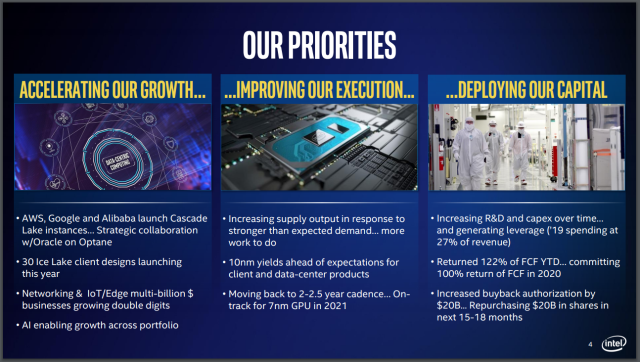buy a cpu, get an xpu or three to go with –
Intel’s 10 nm fumble might be over — but its newer ventures are more interesting.

Enlarge/Intel will begin producing 10 nm products in its Chandler, Arizona, facility as well as the two current (nm facilities in Oregon and Israel.)
Intel’s years -long struggle with the 10 nm manufacturing process may finally be over . The company told investors last week that its 10 nm yields are ahead of expectations for both client and data center products — and it’s bringing a new 10 nm production facility online, as well. Currently, all 10 nm parts are produced in two of the company’s plants: Hillsboro, Oregon, and Kiryat Gat, Israel. But beginning next quarter, Intel’s fabrication facility in Chandler, Arizona, will also be producing 10 nm parts.

Enlarge/Intel claims 10 nm yields are ” ahead of expectations “even before bringing the 10 nm fab in Arizona
Intel Corporation
What we find more interesting than the 10 nm recovery is that Intel still seems to be very serious about pivoting away from being a CPU company. Since 1991, the iconic “Intel Inside” logo has referred to the CPU in your computer, but the company sees more potential in investments in storage, software, networking, AI, and the data center.
This certainly doesn’t mean Intel plans to exit the consumer and server CPU business, but it does herald a large shift in the company’s overall focus. The company estimates the TAM — Total Addressable Market, or the maximum revenue if literally every potential customer bought an Intel product — of its traditional PC and server CPU line at $ 52 billion. However, it sees an additional $ 220 billion TAM potential in what it calls “Data-centric” products in data center, Internet of Things, and networking market segments.
-
Intel wants to shift much of its focus away from the CPU and onto what it’s dubbing the “XPU” —a term it’s pushing which includes GPUs, FPGAs, and other more specialized processors.
-
Intel’s game plan, interestingly, explicitly includes shifting away from a protectionist and defensive focus on CPUs to grow in other areas instead.
Intel Corporation
-
Intel sees a much larger and more profitable market available in what it calls “data-centric” products than its current traditional PC and server market. The company intends to shift its primary focus in that direction.
Intel Corporation
This means the company intends to continue making its heaviest bets in areas such as Optane storage, hardware Artificial Intelligence acceleration, 5G modems , data center networking, and more. The slide that really drives this commitment home comes from Q2’s investor meeting that explicitly shows the company moving from a “protect and defend” strategy to a growth strategy. If this slide were in a sales meeting, it wouldn’t say much — but delivered to the company’s investors, it gains a bit of gravitas.
Most of this was revealed nearly six months ago at the company’s May 2019 investor’s meeting, but the Q3 investor’s meeting last week continues with and strengthens this story for Intel’s future growth, with slides more focused on Optane, network, and IoT / Edge market growth than with the traditional PC and server market.
The company shows its new “data-centric” market as having already caught up with its traditional PC-centric market, with almost 50% of its Q3 revenue derived from data-centric products. The majority of the operating income (roughly speaking, profit) returns from those products is outpacing the traditional market as well.
-
“Other data-centric business segments” refers in part to the company’s Mobileye driver-assist and semi-autonomous vehicle business, as well as Optane and network gear.
-
Intel’s Data Center Group, which includes Xeon processors, has lower revenues but higher margins than its desktop and laptop CPUs.
Intel Corporation
-
Intel positioned the revenue and income slide for its client computing group — desktop and notebook CPUs — third out of three in the slide deck. Growth and margins are lowest here.
Intel Corporation
We can confirm that Intel’s change in focus seems sincere, based on what the company wants most to talk to Ars about. The company does still want to talk about CPUs, but there’s an increasing pressure for coverage of its AI, networking, and even software efforts as the company shifts footing. We believe that this change in focus is likely a good one for consumers, assuming Intel finds the market growth it’s looking for in new segments. With higher growth and margins in newer ventures, consumers can hope that Intel will make good on its stated intent to relax its protectionist stance in the CPU market along the way.





GIPHY App Key not set. Please check settings